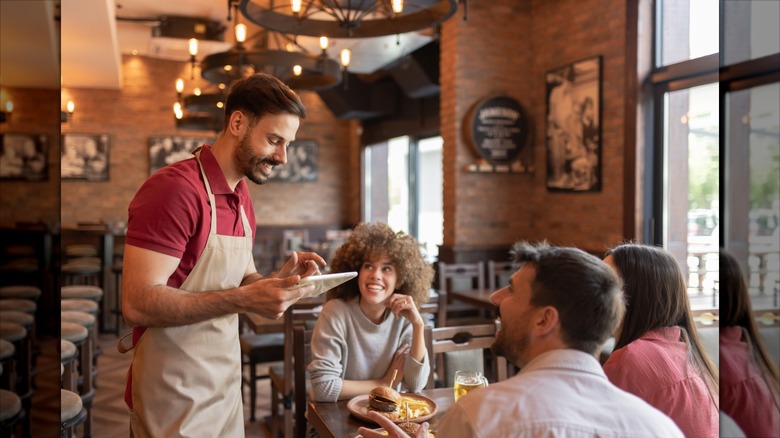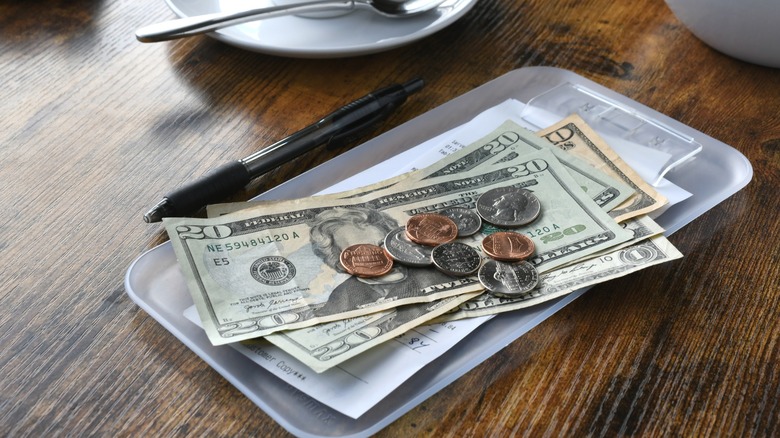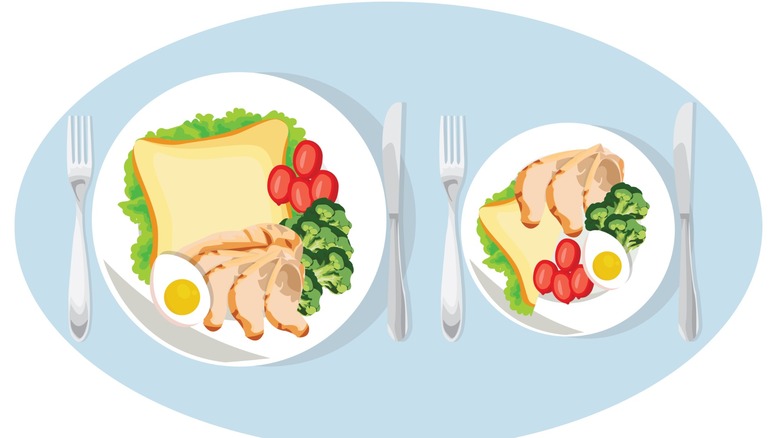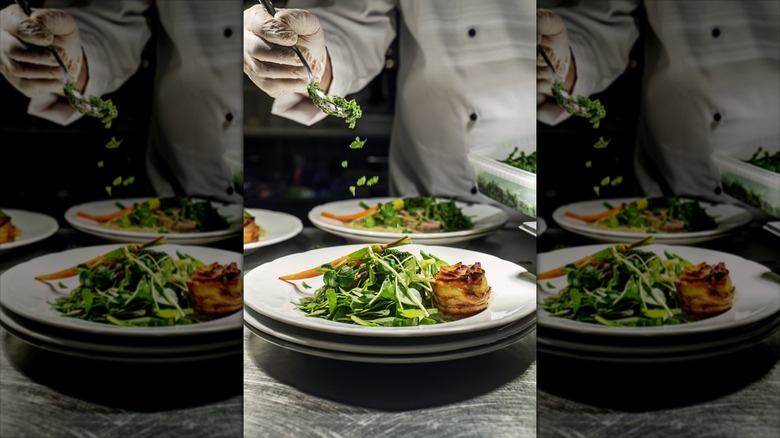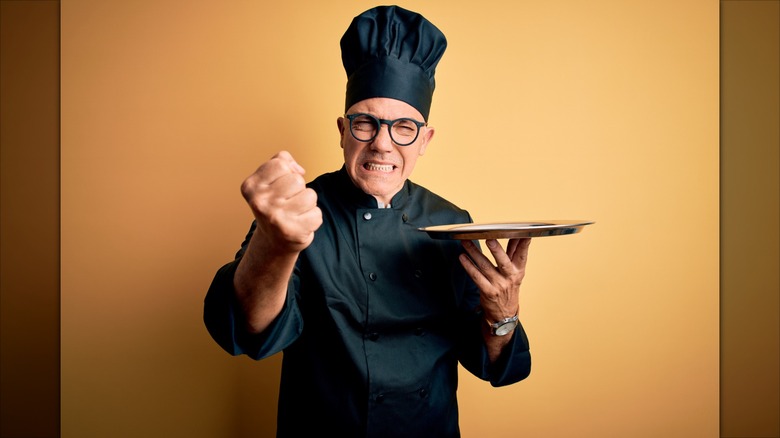11 Differences Between US And European Restaurants You Need To Know Before Traveling
Dining out abroad can be one of the most memorable parts of any getaway, but for Americans traveling to Europe, the restaurant experience often feels surprisingly different from what they're used to back home. From how you're served to how you pay the bill, and even what is on the menu and how it arrives at your table, every stage of a European restaurant visit reflects deeper cultural values and varying perspectives regarding food, time, and hospitality. Understanding these nuances can help avoid frustration, confusion, or even embarrassment, and transform an ordinary meal into a meaningful cultural exchange.
American restaurants often emphasize efficiency, friendliness, and customer convenience. European dining culture leans more toward leisure, tradition, and respect and appreciation for the dining ritual itself. Service may seem slower, portions may seem smaller, or tipping may seem less common, and it all may feel quite wrong in Europe to an American. But it's simply a reflection of a different set of priorities. Appreciating these differences between European and American restaurants can help travelers not only enjoy their meals but also connect more authentically with local customs and etiquette.
This article will explore 11 key differences between U.S. and European restaurants that every traveler should know before booking a table abroad. We'll cover everything from service styles and dining pace to menu design, tipping, and cultural expectations, helping you avoid any restaurant behaviors you might not realize are rude, so you can dine with confidence wherever your travels take you.
European speed is often slower
If you're used to dining in the U.S., where servers practically sprint between tables and refill your drink before you've even noticed it's half-empty, European restaurant service might feel like it's moving at a glacial pace. But stay cool, kids, because that's actually kind of the point. In Europe, eating out is about far more than just feeding yourself. Meals in European restaurants are about savoring food, whiling the night away in conversation, and truly engaging with your company. (The dining tradition of sobremesa comes to mind.)
Knowing this helps you better understand that you're not being ignored when the waiter doesn't check in on you every 10 minutes. Instead, you're being respected. The table is yours for the night, there is no rush, and definitely no (subtle or not) hints that it's time to "turn it over."
In America, where servers often earn just a couple of dollars an hour and heavily rely on tips to equate with a living wage, fast service is tied directly to adequate income. More tables turned means more money earned. In Europe, servers are paid a fair wage, freeing them up to focus on creating a relaxed dining experience, not racing to deliver the next check (and get that tip).
Tipping in Europe is not as expected
While you may have already mastered how to eat spaghetti like Italians do, what about the tipping culture there, and in all of Europe? There's a culture shock moment waiting to happen. Say you finish your meal in Rome, reach into your pocket, and hand over a 20% tip, only to have the waiter look utterly confused by the extra cash. Unlike in America, tipping in Europe isn't a matter of survival for staff. Instead, it's more of a polite way of saying "thank you" for extra great service that went above and beyond. European servers are paid a living wage, and the idea of relying on tips just to be able to make ends meet feels about as foreign there as bottomless coffee refills.
In most European countries, tipping is modest if it occurs at all, with patrons usually rounding up the bill or leaving about 5% to 10% for exceptional service. In some places, such as Italy or France, the restaurant "service charge" (servizio/service compris) is already included in your bill, meaning you've technically already tipped without realizing it.
The beauty of this system is that you can relax. There's no mental math or panic mode about managed expectations at the end of dinner. A small gesture is perfectly appreciated, not expected.
In Europe, you must ask for the check
In the U.S., servers often drop the bill almost before you've even put down your fork, sometimes with a cheerful "no rush!" that clearly means "get the fuggg outta here." In Europe, doing that would be a faux pas of the highest order. Abroad, bringing the check before it's requested is seen as rude, almost as if the waiter is pushing you out the door (imagine that!). In Europe, meals and their flavors are meant to linger, and so is your time at the table.
When you're ready to leave, you'll usually need to ask for the bill, with a friendly gesture or by catching the waiter's eye. (No dramatic arm flailing or snapping necessary.) European servers are masters of reading subtle cues.
If you're pressed for time, don't be shy about politely requesting the check early. It's not rude to ask, just impolite to assume. The European mantra is that the end of a meal should feel as calm as the start, so linger a little, enjoy that post-dinner espresso, have a few laughs, and savor it all. All of which is to say, don't panic if your check doesn't appear instantly.
Portion sizes in Europe are smaller
You've probably been served a plate in the U.S. that feels like it could feed a small family, but expecting that largesse in Europe might leave you set up for a "big" surprise. European portion sizes are noticeably smaller, but not stingy. Instead, they're designed for prime satisfaction (quality) versus absolute excess (quantity). In much of Europe, food is meant to be enjoyed thoughtfully, not inhaled in record time or boxed up for nuking in the microwave later.
Part of this size difference stems from culture, and part from practicality. European meals emphasize freshness and balance, often following the rhythm of multiple smaller courses rather than relying on one oversized main. This tends to leave patrons feeling full, but not stuffed, and likely having room for dessert (and maybe a little digestif), without having to waddle home or need a nap.
Historically, America's "supersize" mentality grew out of abundance and agriculture subsidies that made it cheaper to serve more. Europe, on the other hand, never embraced that arms race of portion inflation. The results are meals that highlight quality ingredients and portion control that aligns with actual appetite. So, when your plate looks smaller than expected, don't feel shortchanged. In Europe, less really is more.
Water and refills are rarely free in Europe
If you're used to being automatically served ice water or endless soda refills in America, you may want to brace yourself. Europe doesn't play that game. In most European restaurants, water isn't complimentary, even if the tap water is perfectly drinkable. Instead, you'll often be asked whether you want still or sparkling, both of which usually come in bottles and cost a few euros. This isn't a scam. It's simply a cultural difference. Europeans tend to view bottled water as part of the dining experience rather than a free utility.
In some places, it is not uncommon for waiters to decline requests for tap water because some restaurants prefer to sell bottled drinks. In countries like France or the U.K., you can request tap water (say "une carafe d'eau" in France), but it's not assumed or served automatically.
So, why the charge? For one, bottled water is a staple in Europe's restaurant culture and is seen as a mark of quality and presentation. Refills, including water, are rarely free. To Europeans, beverages are an intentional part of the meal, not something to be mindlessly refilled. So, the next time you're abroad, order thoughtfully, and maybe just give in to the experience and savor that elegant glass of eau minérale like a local.
Europeans eat dinner later than most Americans
If you're wandering European streets at 5 p.m. and seeing every restaurant closed, all is not lost. You're just too early. Europeans eat dinner later than Americans, and mealtime schedules can differ by region. Across much of Europe, restaurants often close for a time each day after lunch service, then reopen for dinner. In places like France, this rhythm is sacred. The standard lunch there is served from 12 to 2 p.m. Dinner is from 7:30 to 9:30 p.m., with absolutely no in-between.
In Central Europe, you'll find people dining more around 7 or 8 p.m. on average, while in Southern Europe, things can run even later. Italians may sit down around 8 or 9 p.m., often enjoying multiple courses (antipasti, pasta, meat or fish, and then dessert!). Spanish dinners, which tend to run the latest, often start at 9:30 or even 10:30 p.m.
This later repast schedule reflects a slower, more social approach to life. Dinner is not a rushed refueling stop, but more like the main event and time to unwind and connect. Americans visiting Europe should plan accordingly and embrace the night owl eating.
Food quality in America pales in comparison to Europe's
One bite of European bread, cheese, or fruit, and many Americans immediately notice that everything just tastes better. That's not your romantic, vacation brain projecting. It's actually a direct reflection of European regulation and philosophy. Europe's food system is built around the "precautionary principle," which means that if an additive or process might be harmful, it's banned until proven safe. The U.S., by contrast, uses the "Generally Recognized as Safe" (GRAS) standard, which allows any ingredients that aren't clearly dangerous.
The result is that European pantries (and restaurant kitchens) are free from many American additives like potassium bromate, butylated hydroxyanisole (BHA), and certain artificial dyes. Genetically modified foods in Europe must also be labeled, and growth hormones in meat and dairy are outlawed. Pesticide use is tightly controlled as well, and several controversial chemicals, including chlorpyrifos and neonicotinoids, are banned outright. The U.S. takes a looser approach, favoring efficiency and cost over caution.
Europeans also prioritize local, seasonal, and minimally processed foods. Fresh produce markets remain central to daily life, and ultra-processed foods make up a much smaller share of the diet. In the U.S., convenience often outweighs quality. Simply put, Europe's food philosophy (fewer chemicals, more natural ingredients) makes dining a truly superior sensory experience.
When Americans see or say menu in Europe, things can get lost in translation
In the U.S., a restaurant "menu" means the full list of all available dishes. In Europe, ordering from the "menu" often means something entirely different. Across France, Spain, and much of the continent, a "menu du jour" or "menu del dia" refers to a fixed-price, multicourse meal that offers exceptional value and unfolds in several stages. Typically available at lunch, this set "menu" might include a starter, main course, dessert, and even wine or coffee, all for one price.
In France, a "menu" is distinct from "à la carte." You'll often choose between combinations like "entree-plat" (starter and main), "plat-dessert" (main and dessert), or the full "entree-plat-dessert" trio. Similarly, Spain's "menu del dia" features a hearty midday feast for a reasonable cost, reflecting Spain's beloved and cherished tradition of taking long lunch breaks and embracing social dining.
Americans may find this confusing because in the U.S., a "menu" simply lists all dishes and prices each item separately. In Europe, "the menu" is often the best way to enjoy an authentic, affordable meal crafted around fresh, seasonal ingredients. There's also the "formule," a lunchtime version of the set menu, and the "prix fixe" menu in France, which is often reserved for special occasions. Understanding this linguistic twist will save you confusion, and maybe even a few euros, while helping you dine like a local.
In Europe, a meal is an event, not a quick transaction
For Americans, especially those used to grabbing a quick bite between meetings, the European approach to dining can feel like entering another dimension, a dining world where time nearly ceases to exist and no one's in a hurry. Across Europe, meals are seen as experiences to be shared, not tasks to tick off your to-do list. Lunch in Europe can easily last an hour or two, and dinners at restaurants in Europe may stretch for even longer.
Many Americans find this far more relaxed pace challenging. They're used to being greeted immediately, with drinks delivered within minutes and plates cleared the instant they're empty. In European restaurant service, this level of speed can feel almost aggressive. Servers there are trained not to interrupt and to simply allow the party to enjoy the table and all that arrives on it.
This unhurried rhythm encourages connection. Europeans linger, talk, and let the meal evolve organically. It's a reflection of a culture that celebrates food, friendship, and life itself. So, when you sit down to eat abroad, resist the urge to rush. Maybe put the phone away and let the evening unfold the European way.
Added condiments and excessive alterations in Europe are a big no-no
If you're the type to ask for extra ketchup, dressing on the side, or a burger "no bun, add avocado," tread with caution on your next getaway abroad. The simple fact is that Europe isn't fond of customizing orders. In many European restaurants, the dish arrives as the chef intended, and altering it can even be seen as disrespectful to their craft and expertise. Culinary tradition runs deep here, and recipes are carefully balanced in flavor and presentation, including the exact ingredients intended.
In countries like Italy or France, asking for ketchup with your pasta or steak might draw a raised eyebrow or an outright no. It's not rudeness. Let's call it pride. Chefs view their dishes as artistic expressions meant to be tasted as designed. Even condiments like salt or pepper may not be on the table because seasoning is considered part of the cooking process. The unspoken rule, also? Taste before you add.
Of course, if you have dietary restrictions or severe allergies, polite communication is fine, butavoid treating every order like a custom request. Europeans generally believe that if a dish doesn't suit your needs, you should simply order something else. It's mostly about respect for the chef's work and the integrity of the meal.
Splitting dishes is generally frowned upon in Europe
In the U.S., sharing an entree to save money or calories is more accepted than in Europe, and servers might even bring you an extra plate if you ask politely. Abroad, that practice might be met with confusion or even disapproval. Among the reasons why restaurants don't want you splitting a plate is that European portions are smaller by design and priced fairly per diner, so splitting a single dish undermines both the meal's intent and the restaurant's economics.
It's perfectly fine to taste a friend's meal or exchange bites, but outright sharing one entree between two people is considered impolite as a general rule. In Italy, for example, meals are structured by course, and each person is expected to order at least one. The idea is that dining out is a shared social ritual, not a bargain hunt. Because leftovers and doggie bags are also pretty uncommon in Europe, meals are meant to be enjoyed individually and finished completely.
When traveling in Europe, the best etiquette is simple. Order your own dish, enjoy your portion, and maybe trade a bite or two if you can't resist the enticing fare on your companion's plate.
